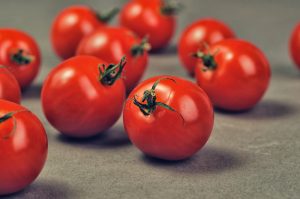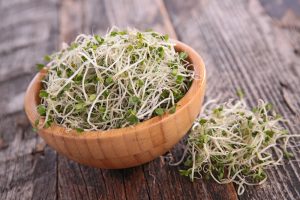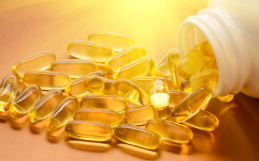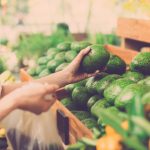There are several ways to make your food more nutrient dense.
What is nutrient density? It is the difference between eating a 150 calorie twinkie or 150 calories worth of almonds. Huge difference in what your body can use the food to accomplish. This same serving can either build your body up (almonds) or break your body down (twinkie).
Check out the following videos to learn more about nutrient density in food:
- Paleo Foods are the Most Nutrient Dense — Chris Kresser
- Nutrient Density: Sticking to the Essentials AHS12 — Matt Lalonde
So what are the top hacks we can use to make our food as healthy as possible?
1. Bone Broth
 What’s all this about bone broth? You can read my post about it here or check out the recipe that I recommend using. If you’re convinced, but not ready to make it, you can also buy it ready-made here.
What’s all this about bone broth? You can read my post about it here or check out the recipe that I recommend using. If you’re convinced, but not ready to make it, you can also buy it ready-made here.
If you want a deeper look into the health and science behind bone broth, see the following video: Bone Broth and Health: A Look at the Science — Kaayla Daniel, Ph.D., CCN (AHS14)
Bone Broth Hack #1: Add powdered gelatin to cold water and let it sit for five minutes. Instant bone broth. You can also add gelatin to your smoothie. To thicken your smoothie put two scoops and let sit for five minutes or put in the freezer.
Bone Broth Hack #2: Put all my vegetable scraps for the week in a bag in the fridge. Then when you are at the last 2-3 hours of making your broth, dump everythinng into the mixture! Waiting until the last 2-3 hours will preserve most of the nutrients in the veggies.
2. Garlic
In Jo Robinson’s Eating on the Wild Side: The Missing Link to Optimum Health, her cutting-edge research, which includes examining more than 6,000 scientific studies, describes in detail how, over the course of four hundred generations, we eliminated nutrients and replaced our once-wild fruits and vegetables with better-tasting, easy-to-harvest varieties that are full of starch and sugar, but lack the vitamins, minerals, and polyphenols of the original wild versions.
You can cook garlic and reap all its benefits if you make a simple change to the way you prepare it. Chop, mince, slice, or mash it then keep it away from the heat for 10 minutes. During this time, the maximum amount of allicin is created. Garlic’s health-promoting property is a compound called allicin, which is only created when two substances isolated in a garlic bulb come in contact with each other. Heating immediately after crushing or mincing eliminates the formation of allicin.
3. Tomatoes
Also, according to Jo Robinson, the old idea that “a tomato is a tomato is a tomato” no longer holds. Tomatoes were given a major makeover during the 19th and 20th centuries to make them more productive, uniform, and attractive.
The nutritional consequence wasn’t known until a century later. The reason the new varieties are a solid color is that they have a mutant gene that makes them ripen uniformly. It has an unforeseen negative effect: it lowers the lycopene content, making them less nutritious. Today, virtually all our modern tomatoes carry this mutant gene and are lower in lycopene.
 If you know how to identify the most nutritious tomatoes in the market, you can triple or quadruple your intake of lycopene. Choose tomatoes by color. The darkest red have the most lycopene. Shopping by size is just as important. Small, dark red tomatoes have the most lycopene per ounce and they’re also sweeter and more flavorful. Small tomatoes also have more vitamin C. The smaller-is-better rule applies to varieties within a category.
If you know how to identify the most nutritious tomatoes in the market, you can triple or quadruple your intake of lycopene. Choose tomatoes by color. The darkest red have the most lycopene. Shopping by size is just as important. Small, dark red tomatoes have the most lycopene per ounce and they’re also sweeter and more flavorful. Small tomatoes also have more vitamin C. The smaller-is-better rule applies to varieties within a category.
Tomatoes are better cooked than raw. The longer you cook them, the more health benefits you get. Heat breaks down the cell walls, making nutrients more bioavailable. Second, it twists the lycopene molecule into a new configuration that’s easier to absorb.
The most nutritious tomatoes are in the canned goods aisle. Processed tomatoes are the richest source of lycopene. The heat of canning makes lycopene more bioavailable and tomatoes grown for the food industry are picked when red-ripe and processed immediately. No flavor is lost along the way. Tomato paste has up to 10 times the lycopene than raw tomatoes.
Most tomatoes are packed in cans that have a plastic lining that contains a noxious chemical called bisphenol A (BPA). Look for tomato products sold in glass jars or BPA-free cans. Another option are aseptic containers — coated paper containers, which allow food to be stored for months without refrigeration.
4. Broccoli and Broccoli Sprouts
 Keep broccoli cool and don’t overcook! According to Jo Robinson, most broccoli sold in farmers markets is impeccably fresh and highly nutritious. Look for a vendor who has the broccoli on ice or in a cooler. In order to preserve nutrients, broccoli must be chilled as soon as harvested, kept cool, and then eaten within two to three days.
Keep broccoli cool and don’t overcook! According to Jo Robinson, most broccoli sold in farmers markets is impeccably fresh and highly nutritious. Look for a vendor who has the broccoli on ice or in a cooler. In order to preserve nutrients, broccoli must be chilled as soon as harvested, kept cool, and then eaten within two to three days.
In a study, broccoli was exposed to the warmer, drier conditions of a supermarket. At the end of 10 days, it lost 80% of glucosinolates, 75% of flavonoids, and 50% of vitamin C.
Eating broccoli raw gives you 20 times more of a beneficial compound called sulforaphane than cooked. Sulforaphane provides much of the vegetable’s anticancer properties. If you cook broccoli in boiling water, half the glucosinolates will leach out. If you deep fry, you lose even more. Microwaving can destroy half its nutrients in two minutes. One of the best ways is to steam it for no more than four minute to retain the most nutrients.
Another recommended way to cook is to sauté in extra virgin olive oil and garlic. The vegetables will absorb the phytonutrients in the oil and garlic, which can make it even more nutritious.
Try a simple and very affordable mason jar-method of sprouting broccoli. Johns Hopkins scientists have found that broccoli sprouts are a new and highly concentrated source of sulforaphane (50-100 times more than normal broccoli), a compound they identified in 1992 that helps mobilize the body’s natural cancer-fighting resources and reduces risk of developing cancer.
Check out the following resources to learn more about it:
5. Eggs
Cook your eggs by cooking the white first and then put the yoke in, so you don’t oxidize the cholesterol.
6. Rice
When cooking rice, add trace minerals to the mix. I use this technique and also add healthy oils to increase the nutrient density of the rice. Refrigerating rice increases its resistant starch which makes it less glycemic (and feeds the beneficial bacteria in your gut) and then you can add all the vegetables and meats. I typically cook and reheat rice or quinoa in bone broth.
7. Kale
Cut up kale the day before and let it sit in the fridge overnight. If you do this and use it the next day, then it will release more nutrients. Steam lightly before use to reduce the amount of oxalates that bind to calcium (see article for more info).
8. Soak Your Nuts and Seed
Soaking improves the bioavailability of these foods. I always keep my chia seeds soaking in a glass jar, so that they are ready for a shake at any time.
Enjoy! Buen provecho!












